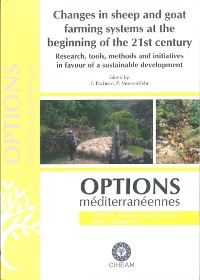| Article précédent | p. 95-97 | Article suivant |
Description of Palmera sheep production system
78.5 percent of Palmera sheep flocks registered in the official herd book, were surveyed according to different aspects: composition of flock, feeding management, productive and reproductive parameters and economic indicators. The average flock size (21.0 ± 20.0 sheep) was small and with a high variability (CV 0.95). Farmers were not too young (50.5 ± 17.3) and sheep were not their principal activity (only 0.83 ± 0.51 familiar UTA). Grazing was the most extended practice; nine of the eleven farms surveyed used natural pastures and forest for direct sheep grazing. Average percentages of fertility and fecundity were 97.9 percent ± 3.10 (CV 0.03) and 127.4 percent ± 28.8 (CV 0.22) respectively; percentage of lamb mortality was 8.6 percent ± 7.20 (CV 0.83). Principal income was local subsidy and not lamb meat. Under these conditions, recovery of Palmer sheep is based in the good adaptation of the breed to the local conditions, an efficient use of natural resources, a right subsidy policy and a getting on with the measures aimed at promoting lamb meat.
78,5 pour cent des troupeaux de moutons Palmera enregistrés dans le livre officiel ont été étudiés en fonction de différents aspects : composition des troupeaux, gestion de l'alimentation, production, reproduction et indicateurs économiques. La taille moyenne du troupeau (21,0 ± 20,0 moutons) est faible, avec une forte variabilité (CV 0,95). Les éleveurs ne sont pas très jeunes (50,5 ± 17,3 ans) et l'élevage ovin n'est pas leur activité principale (seulement 0,83 ± 0,51 UTA familiale). Le pâturage est la pratique la plus répandue ; neuf des onze exploitations enquêtées utilisent les prairies naturelles et les forêts directement pour le pâturage des moutons. Les pourcentages moyens de fertilité et de fécondité sont de 97,9 pour cent ± 3,10 (CV 0,03) et 127,4 pour cent ± 28,8 (CV 0,22), respectivement ; le pourcentage de mortalité des agneaux est de 8,6 pour cent ± 7,20 (CV 0,83). Le principal revenu est la subvention locale et non la viande d'agneau. Dans de telles conditions, l'entretien des moutons Palmera est basé sur la bonne adaptation de la race à la situation locale, une utilisation efficace des ressources naturelles, une bonne politique de subvention et de promotion de la viande d'agneau.
- [ Afficher ]
- [ Télécharger ]
- [ Exporter la citation ]
Vous pouvez télécharger la citation au format :
- [ Imprimer ]
-
Mots-clés
CANARIES (ILES), INDICATEUR, OVIN, PERFORMANCE ANIMALE, RACE INDIGENE, RESULTAT DE L'EXPLOITATION AGRICOLE, SYSTEME D'EXPLOITATION AGRICOLECiter cet article
Fernández G., Bravo M.J., Novo A., Navarro-Ríos M.J., Capote J. Description of Palmera sheep production system. In : Pacheco F. (ed.), Morand-Fehr P. (ed.). Changes in sheep and goat farming systems at the beginning of the 21st century : research, tools, methods and initiatives in favour of a sustainable development . Zaragoza : CIHEAM / DRAP-Norte / FAO, 2009. p. 95-97. (Options Méditerranéennes : Série A. Séminaires Méditerranéens; n. 91). Proceedings of the Seminar of the Subnetwork on Production Systems of the FAO-CIHEAM Network for Research and Development in Sheep and Goats, 2007/11/15-17, Ponte de Lima (Portugal). http://om.ciheam.org/om/pdf/a91/00801133.pdf



